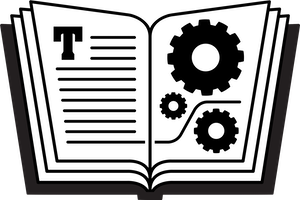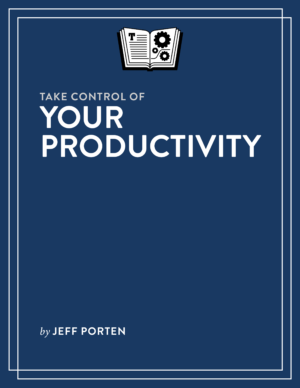Posted by Jeff Porten on July 16, 2018
I just gave an interview on Brett Terpstra’s Systematic podcast, when this AppleScript I’ve written came up. It creates a link for any email you’ve selected in Mac Mail and puts it on the clipboard. You can then paste it into any notes field or document elsewhere—in most apps, it’ll automatically be treated as a link and clickable. Opening it takes you to the message. This is better than most systems of copying-and-pasting text, or forwarding email to other apps, because it’ll show you the message in its original context.
There are various tools to launch AppleScripts, but the easiest (which doesn’t require any additional software) is the Script Menu. Instructions here. Once it’s turned on, open the Script menu (right side of the menu bar) and choose Open Scripts Folder > Open User Scripts Folder. Create a folder there named “Applications”, then one inside it named “Mail”. Put this AppleScript in that folder—the script will only show up in the menu when Mail is the front application.
Select a message, choose the Get Message URL script, switch to any other app, and paste the clipboard into any text field. Done. Usually you’ll see something like this:
message://%3c32A1456C-B027-40C1-8147-AE462EB38BC4@jeffporten.com%3e
…but some apps (like Mac Calendar) interpret the link; Calendar shows “Show in Mail…” if you paste it into the URL field, which is really weird because you need a script like this one to get the link in the first place. You’d think Apple would have set that up as a Mail command by now. If the link isn’t clickable, almost always you can select it, right-click on it, and choose Open URL from the contextual menu.
Just now realizing I can’t post attachments here, so head over to my website to pick up the script. It’s free for anyone who’s bought the book.
Posted by Jeff Porten on June 26, 2018
Unfortunately this didn’t come to my attention in time to include in the book, but OmniFocus 3 for Mac is due in September. No official word yet on when it’ll be available in the limited web version for other devices.
https://www.omnigroup.com/blog/omnifocus-3-for-mac-to-ship-in-september
Posted by Jeff Porten on June 18, 2018
(updated June 22, 2018)
Try these two statements on for size, and how you would react to hearing them:
“I have diabetes, and every day I take insulin and watch my diet. If I get really sick, I might need to go to the hospital.”
“I have mental illness, and every day I take medication and watch my mood. If I get really sick, I might need to go to the hospital.”
Not quite the same, was it? Sure, you probably felt sympathy in both cases—but let’s say you heard that from two teenagers applying to be your babysitter. You’d treat them both the same? If your answer is yes, congratulations—you have better attitudes about mental illness than many of the mentally ill do.
Note: If you just thought to yourself, “Well, diabetes won’t affect my kid, but a crazy person might,” guess what? Diabetes can make you crazy. It’s true! So perhaps think twice about using that word next time?
Fact: Your Brain Lives in Your Body
It’s not a universal cultural thing, but it’s definitely American: we take physical illnesses seriously, but treat mental illnesses as if they’re personality quirks.
Just look at the words we use. “Physical” illness. “Mental” illness. “Mental” things live in your mind—by definition, a surgeon can’t get to them, so everyone thinks it’s more of a touchy-feely gray area. But turns out, your brain is made of meat, just like the rest of you, excepting the grisly and bony bits. We don’t have much of a clue how minds arise from the electrical activity in our brains, but the best current guess: it’s a naturally emergent effect, and it’s not accurate to think of our minds as non-physical.
When the average person thinks mental illnesses are less important or valid than “real” illnesses, that’s an annoying societal quirk, which makes the lives of the mentally ill more difficult in hundreds of major and minor ways. But the real damage is that the mentally ill live with those people, and unconsciously pick up the same attitudes.
Note: Humans are wonderful creatures capable of amazing things. We’re also astonishingly ignorant, and completely unaware that we are. This is true of most people’s understanding of mental illness. With few exceptions, if someone is not medically trained, diagnosed themselves, or has not personally cared for someone with mental illness, they are at worst dangerously wrong, and at best, not knowledgable at a level of detail that could be useful.
You’ve heard of that phenomenon where middle-aged men are too stubborn for their own good? When they experience chest pain they tough it out, instead of doing the sensible thing and going to a hospital? It’s ten times worse for mental illness. Here’s the horrible, horrible process most people go through:
First, you realize that awful feeling, or lack of capability, or inability to see things blindingly obvious to people around you, dovetails a bit with what you’ve heard about a particular mental illness.
You roll this idea around for a while, trying it on for size. Maybe you do some research on the internet. This takes months.
Eventually, things have gotten worse, but by now you’ve read a dozen internet articles, and heard from a dozen friends, telling you how to “manage” your self-diagnosis through diet, exercise, crystals, and—no kidding—wishing it away with a better mental attitude. Or you’ve found naturopathic and homeopathic “cures,” because drinking teas brewed from a dozen physiologically-significant herbs that may or may not match what it says on the bottle, and were made in Chinese factories with no oversight and no attention to dosage or adulterants, sounds safer than “Western for-profit medicine.”
Note: There is a scientific term for any alternative medicine that has been researched and proven to work. It’s called “medicine.” Anything that is still “alternative,” by definition, hasn’t been proven to a rigorous standard (which is usually a polite way of saying “to any standard”). Also note: some peddlers of alternative medicine refer to science as “allopathic medicine;” when you hear this, substitute “medicine that is proven to work.”
You try some of these things, especially the easy ones that don’t hurt or cause much inconvenience. When they fail, and they almost always do (dietary and behavioral changes certainly can help, but after diagnosis and in addition to proper care), you didn’t do it “right” or “hard enough.” There’s always a reason why a quack therapy is still perfect, and the problem is you.
Finally, after all of this—and sometimes, it’s several years later—something gives. You can’t tell yourself you’re not broken anymore. Maybe you’ve tasted, or gorged upon, some flavor of “hitting bottom.” If you hit bottom really spectacularly, you’re forced to seek help by a spouse ready to leave, or by a court.
You seek help.
Here’s the same process for physical illness:
Something hurts more than an Advil can handle, or your body just “feels weird” in an unfamiliar way.
You see a doctor, maybe two.
You get a diagnosis.
You get treatment.
Have I made my point about how fundamentally silly this is yet?
Words Matter
The two common disorders that I mention in the book—because they’re the ones I know best, for self-serving reasons—are depression and attention deficit hyperactivity disorder (ADHD). They are both poorly named, and these misnomers have radically dangerous effects for those who suffer from them.
The problem with “depression” is that we use the same word for all sorts of mental states. You’re depressed your favorite show was canceled. You’re depressed a friend can’t show up at your party. You’re depressed your dog died. You’re depressed for no obvious reason and you don’t get out of bed or shower for two months.
Note: On the topic of one word having two different meanings, with adverse effects, see also “theory:” the word for your opinions about the next season of Star Trek: Discovery; also the word for a scientific principle so well-established that we non-experts should treat it as a certainty, until a consensus of experts say otherwise for a few decades running. (When scientists have an informed opinion they’re still testing, it’s called a “hypothesis,” not a theory.)
This is called a “category error:” you think you’re talking about one thing, but you’re talking about something else entirely. Everyone’s an expert on their own “normal” depression, and fewer have experience with the clinical type; by definition, then, you’re going to hear much more often from people who think they’re experts on clinical depression, as opposed to people who have some idea what the hell you’re going through.
Meanwhile, the same thing happens for ADHD, thanks to both the word “attention” and the word “hyperactive.” Everyone has an attention span, and everyone loses focus from time to time, so they’re brimming with advice: “Go jogging, it’s wonderful!” My response to such people: “That’s great. Call me when you’re three hours late to your own wedding, you’ve repeatedly dropped out of college, or you’ve held 30 jobs in six years.”
Regarding hyperactivity, we have a different problem. At the risk of stating an unpopular opinion, ADHD in the early 21st century is likely extremely overdiagnosed in children, and extremely underdiagnosed in any adult old enough to have missed the grade school window we’ve established to look for it. (Of course that kid is full of energy and unfocused; he’s a child. Medicate him if he is suffering, not because his parents or teachers are.)
But hyperactivity is sometimes only a symptom in children; adults may grow out of the uncontrollable and inappropriate energy, while retaining the mental issues. As a result, they no longer identify with the most well-known symptoms, and this can lead to misunderstanding the problem. Or they simply think that ADHD is a kid thing and they’re immune.
Note: Some mental illnesses have a genetic component. If a family member is diagnosed with one of these, you’re more at risk for it. When it’s your parent who has it, it’s something you might get later. When it’s your child, it’s something you may have had for decades, and have gotten so good at masking you’re not even aware you’re compensating for anything.
For most mental illnesses, the afflicted are physiologically incapable of achieving a mental state that everyone else takes so completely for granted, they’re not aware it is a mental state.
The list of things that can ruin your life doesn’t stop there, of course. Agoraphobia, panic attacks, extreme shyness, some kinds of fatigue syndromes (for which the jury is out whether they’re physical or psychological—which for our purposes doesn’t matter); there are many wild and inventive ways a brain can break.
When to Seek Help
If you’re nodding your head while you’re reading this? Right now.
No, really. Around 20% of you are recognizing yourselves, or are being reminded of that time when you started the “trying it on” stage of considering whether you had a problem. 20% more of you are thinking about the family member or close friend who really needs to read this.
Seeing a psychotherapist or a psychiatrist for the first time is scary, no different than seeing an oncologist, because there’s only one thing you want to hear and it’s two words long. The thing is, here’s what happens in your first session if you don’t have anything wrong with you:
You talk for a while. A psychiatrist will likely walk you through a questionnaire. A psychotherapist may do that as well, or ask you a bunch of free-form questions.
The mental health expert you’re talking to comes to an initial hypothesis regarding your diagnosis, starting with whether you have one at all. At worst, this takes an additional session or two. (Mine took 30 minutes.)
If you don’t have a clinical problem, you get excellent advice about how to deal with the problems that brought you there, from someone with years of intensive education, and the experience of talking to 1,000 patients with problems similar to yours, perhaps much more severe or debilitating.
You go home and do those things. If you need more advice, you can go back. Most people kind of like it after they get comfortable.
“But wait,” you might say. “Sure, it’s easy if everything’s fine. But what if there’s something seriously wrong with me? That’s scary.”
Yes. Yes, it is. But please note: if that happens, there is something seriously wrong with you. Which other chronic, incurable, life-destroying illnesses do you apply this strategy to?
Please refer to the bullet point earlier, the one that said, “First, you realize you might have a mental illness.” That moment, the one that comes at the beginning of wasted years and needless pain? That’s when you seek help.
For my male readers: Meanwhile, if you have chest pains, go see a frickin’ doctor. And get your colon examined, schmuck.
Where to Get Help
I intend to add a few pages here shortly. In the meantime, start your research where I’ll start mine, at the National Alliance on Mental Illness.
Want more? All the Links to Take Control of Your Productivity Web Content
Posted by Jeff Porten on
(updated June 20, 2018)
As I write this, the book is getting published within hours and I’m still finalizing what’s going into the web materials. Unfortunately, this post is the one for which I have the least prepared right now, which I’ll fix as soon as I can.
In the meantime, here are the Big Three books about which I’ll have much to say later:
Seven Habits of Highly Effective People by Stephen Covey
Getting Things Done, by David Allen
The Now Habit, by Neil Fiore
Want more? All the Links to Take Control of Your Productivity Web Content
Posted by Jeff Porten on
(updated July 16, 2018)
Take Control of Your Productivity contains several links to web content that either didn’t fit in the book’s length, or didn’t apply to all readers (but was too useful for some to leave out entirely). I might also add new posts. For your convenience, they’re all indexed here.
July 16, 2018: Create a link to any email message in Apple Mail (Mac)
June 26, 2018: OmniFocus 3 for Mac shipping in September
June 20, 2018: Other Productivity Books Worth Reading
June 20, 2018: You Can’t Fix Your Mental Health with Tools—if you think you might have symptoms of depression or ADD, or know someone who does, please read this.
June 20, 2018: How Not to Take a Vacation
June 20, 2018: Tech Tips and Tricks for More Productivity
June 20, 2018: Additional Task Apps to Consider—coming soon, as new ones arrived just as I was finishing the book (and that was 12 hours ago at this moment). These will be added to Task Apps to Consider with the dates they’re added so you can tell what’s new.
June 20, 2018: Task Apps to Consider
June 20, 2018: All the Links to Take Control of Your Productivity Web Content, which being this post, probably doesn’t need to be indexed.
Posted by Jeff Porten on
(updated June 20, 2018)
If you have two different computers (most commonly, a Mac at home and Windows at work), there are a few ways to handle this. None of them are thrilling.
Cross-platform apps: The seemingly obvious solution is to pick an app that can live in both places. There are problems with this: first, there are very few app options here, and you’re much more likely to fit yourself to the software than the reverse. Second, if your data lives on your company’s hardware, they legally own it, and can review it (or demand passwords) at any time.
Web apps: Usually preferable to native applications (in this situation only). Your data lives in the cloud, so no one at work can get to your database. But it has the same lack-of-options downside: web apps are less complex than native applications (usually; Salesforce is a major exception).
Run Windows on your Mac: There are several ways to run Windows software on your Mac. This actually works really well. The issue is, spoiler alert, Mac apps are just better across the board: more choices, better design. The how-to for this is a book on its own (and unfortunately, Take Control’s book about it is out of print), but here are the software names to Google to get you started: Boot Camp, Parallels Desktop, VMware Fusion, VirtualBox.
Run Mac on your PC, sort of: You can’t run Mac apps on a PC, but you can share the screen of your Mac at home. You see the screen on your Windows monitor, anything you type or mouse gets sent home, your Mac does the work and sends back the screen. It’s not perfect—there’s a little lag, and sometimes everything pauses for a few seconds if the Internet connection slows down. The main problem, though, is that you need to leave your Mac running at home to use it, and some tech wizardry is necessary to set up your home router. Get started here: how to share the screen on your Mac, and software you’ll need on Windows.
I think most people will be served best by a task app that runs on mobile hardware that they own. Run your task app on a tablet, and you can prop it up side-by-side with either computer, using pointers to make any organization use do on all three perfectly manageable.
Want more? All the Links to Take Control of Your Productivity Web Content






Reviews
There are no reviews yet.